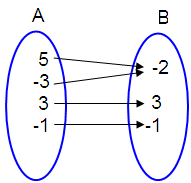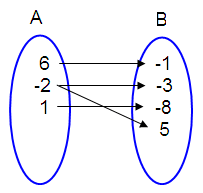FINDING DOMAIN AND RANGE FROM ORDERED PAIRS
Problem 1 :
Identify the domain and range of the given relation.
Then
represent the relation using a graph and a mapping diagram.
(-2, 3), (1, 2), (3, -1), (-4, -3)
Solution :
(-2, 3), (1, 2), (3, -1), (-4, -3)

In the above
arrow diagram, each element of A has image in B and also each element of A has
only one image in A.
So, the given relation is a function.
Domain is the elements of A.
Domain = {-2, 1, 3, -4}
Range is the elements of B.
Range = {3, 2, -1, -3}
Problem 2 :
(5, -2), (-3, -2), (3, 3), (-1, -1)
Solution :
(5, -2), (-3, -2), (3, 3), (-1, -1)

In the above
arrow diagram, each element of A has image in B and also each element of A has
only one image in A.
So, the given relation is a function.
Domain is the elements of A.
Domain = {5, -3, 3, -1}
Range is the elements of B.
Range = {-2, 3, -1}
Problem 3 :
(6, -1), (-2, -3), (1, 8), (-2, 5)
Solution :
(6, -1), (-2, -3), (1, 8), (-2, 5)

In the above
arrow diagram, each element of A has image in B. But the element -2 in A has
more than one image in B. (two images -3 and 5).
So, the given relation is a not function.
Problem 4 :
(-7, 4), (2, -5), (1, -2), (-3, 6)
Solution :
(-7, 4), (2, -5), (1, -2), (-3, 6)

In the above
arrow diagram, each element of A has image in B and also each element of A has
only one image in A.
So, the given relation is a function.
Domain is the elements of A.
Domain = {-7, 2, 1, -3}
Range is the elements of B.
Range = {4, -5, -2, 6}
Problem 5 :
(5, 20), (10, 20), (15, 30), (20, 30)
Solution :
(5, 20), (10, 20), (15, 30), (20, 30)

In the above
arrow diagram, each element of A has image in B and also each element of A has
only one image in A.
So, the given relation is a function.
Domain is the elements of A.
Domain = {5, 10, 15, 20}
Range is the elements of B.
Range = {20, 30}
Problem 6 :
(4, -2), (4, 2), (16, -4), (16, 4)
Solution :
(4, -2), (4, 2), (16, -4), (16, 4)

In the above
arrow diagram, each element of A has image in B. But the element 4 and 16 in A
has more than one image in B. (four images -2, 2 and -4, 4).
So, the given relation is a not function.
Problem 7 :
What is the domain of the relation given by the ordered pairs (-4, 2), (-1, -3), (1, 4), (1, -3), and (2, 1)?
A) -3, 1, 2 and 4 B) -4, -1, 1, and 2
C) -4, -3, -1, and 2 D) -4, -3, -1, 1, and 2
Solution :
The domain of the relation is option B -4, -1, 1, and 2.
Recent Articles
-
Finding Range of Values Inequality Problems
May 21, 24 08:51 PM
Finding Range of Values Inequality Problems -
Solving Two Step Inequality Word Problems
May 21, 24 08:51 AM
Solving Two Step Inequality Word Problems -
Exponential Function Context and Data Modeling
May 20, 24 10:45 PM
Exponential Function Context and Data Modeling